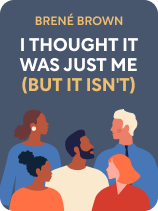

This article is an excerpt from the Shortform book guide to "I Thought It Was Just Me (but it isn't)" by Brené Brown. Shortform has the world's best summaries and analyses of books you should be reading.
Like this article? Sign up for a free trial here.
Where does shame come from? How can you understand what shame is?
Understanding shame is the first step in acknowledging it and overcoming it. According to Brené Brown in I Thought It Was Just Me (but it isn’t), taking control of shame means identifying what causes it in the first place.
Put shame in the past by acknowledging it with these steps.
Understand Your Shame and What Causes It
To start building empathy and combating shame, you must recognize when you’re experiencing it and what’s causing it. Understanding shame and its causes will allow you to separate from your negative thoughts and emotions before they can cause you to experience fear, react with blame, and become disconnected from yourself and others. Acknowledging your shame will enable you to practice courage, compassion, and connection.
There are two parts to this practice. The first is to identify how shame feels. The second is to identify the identities and situations that cause that shame.
Overcoming Shame by Breaking Neuroassociations
In Awaken The Giant Within, Tony Robbins agrees that the key to overcoming negative actions and reactions (like shame, fear, blame, and disconnection) is to identify what’s causing them. In his view, these actions and reactions are caused by neuroassociations: connections in our brain that form between experiences and emotions. These connections help us identify and avoid situations that might cause pain.
Robbins explains that all of our actions and reactions are the result of these neuroassociations. For example, if you’re shamed for wearing your favorite old sweater, you’ll form a negative neuroassociation between “wearing old clothes” and “shame,” and you’ll avoid wearing old clothes in public in the future. Robbins says that uncovering and correcting these neuroassociations is the key to combating negative actions and reactions like shame.
Step #1: Identify How Shame Feels
Brown explains that you can identify shame by reflecting on how it feels in your body. She says shame feels different for everyone—for some people, it might feel like a knot in their stomach, and for others, a pounding in their chest.
To identify how you react to shame, think of a recent experience you’ve had with shame—where in your body did you feel its physical effects? What did they feel like? For example, you might have felt burning, throbbing, or numbness. Are there any other sensations you experience? For example, maybe you get a metallic taste in your mouth. Are there any instincts that pop into your mind? For example, you might want to run, fight, hide, or yell.
Remember how shame feels for you so you can recognize it the next time it crops up and stop it from controlling your thoughts, behaviors, and actions.
(Shortform note: Sometimes, it can be difficult to recognize experiences of shame, even when we’re reflecting on past experiences as Brown recommends. If you’re still struggling to identify experiences with shame, some experts recommend conducting Brown’s recommendation backward: First, understand common reactions to shame. Then, use this knowledge to identify situations where you reacted similarly and might have been experiencing shame. Once you’ve identified experiences of shame, you can then expand on how they felt as Brown recommends. Experts explain that some common reactions that might indicate you’re experiencing shame are sudden feelings of panic, difficulty breathing, the urge to flee, or flashbacks to traumatic events.)
Step #2: Identify the Root Causes of Your Shame
Brown explains that to identify the root causes of your shame, you must confront the disdained identities that trigger you. To do this, consider the identities that you value and want to uphold and the identities that you look down on and don’t want to be associated with. For example, if you highly value the identity of being smart, one of the causes of your shame might be being associated with the opposite—being stupid.
Identifying the identities you disdain is crucial for two reasons. First, it allows you to recognize situations that may trigger your shame so that you can respond productively with courage and compassion rather than being consumed by fear and blame. Second, identifying the identities you disdain will indicate which negative beliefs you need to work on overcoming so they no longer cause you shame—we’ll discuss this further in Practice #2.
Identify Your Disdained Identities Through Self-Testing
While identifying your shameful identities may provide the benefits Brown lists, the process might not be as straightforward as she presents. Psychologists explain that identifying core beliefs (like the identities you disdain and why you disdain them) can be difficult because they’re often deeply ingrained and unconscious. So, Brown’s advice might not be enough to pull them from the depths of your mind.
Instead, experts recommend conducting a self-observational experiment. For one week, immediately write down every negative thought that pops into your head—in Brown’s context, ones that pertain to someone’s (or your own) identity. For example, if you see someone wearing ripped jeans and cringe at their fashion sense, write it down.
At the end of the week, reflect on each negative thought to uncover patterns and the negative core beliefs that caused them. In Brown’s context, this would mean analyzing your thoughts to ascertain which disdained identities caused them and uncovering why you hold those beliefs about that identity. For example, maybe you realize that you have a pattern of looking down at people who dress in a way you perceive as “revealing.” This might be because you went to a conservative private school where this style was banned for being “inappropriate.”

———End of Preview———
Like what you just read? Read the rest of the world's best book summary and analysis of Brené Brown's "I Thought It Was Just Me (but it isn't)" at Shortform.
Here's what you'll find in our full I Thought It Was Just Me (but it isn't) summary:
- Brené Brown's guide on what shame is, why it happens, how it impacts our lives
- How to build empathy and combat shame
- Why it's important to talk about shame with others






